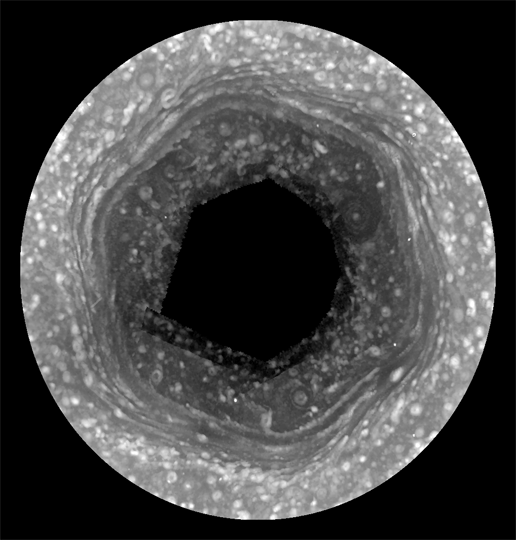 This movie from Cassini, made possible only as Saturn's north pole emerged from winter darkness, shows new details of a jet stream that follows a hexagon-shaped path and has long puzzled scientists.
This movie from Cassini, made possible only as Saturn's north pole emerged from winter darkness, shows new details of a jet stream that follows a hexagon-shaped path and has long puzzled scientists.
The Cassini spacecraft was able to take another look at one of Saturn's strangest features – a bizarre six-sided cloud structure circling the entire north pole. This structure was hinted at when the Voyager spacecraft first visited the planet nearly 30 years ago, and Cassini was able to take a brief look a few years ago with Cassini's infrared camera. But these latest images provide evidence the hexagon-shaped jet stream is still there, (the north pole has been shrouded in darkness but has now recently emerged into sunlight) and gives scientists the most detail yet to study the intriguing hexagon shape crowning the planet.
The hexagon shape is the path of a jet stream flowing around the north pole, and new images reveal concentric circles, curlicues, walls and streamers not seen in previous images. Much to the delight and bafflement of Cassini scientists, the location and shape of the hexagon in the latest images match up with what they saw in the Voyager pictures.
"The longevity of the hexagon makes this something special, given that weather on Earth lasts on the order of weeks," said Kunio Sayanagi, from the Cassini imaging team. "It's a mystery on par with the strange weather conditions that give rise to the long-lived Great Red Spot of Jupiter."
The hexagon was originally discovered in images taken by the Voyager spacecraft in the early 1980s. It encircles Saturn at about 77 degrees north latitude and has been estimated to have a diameter wider than two Earths. The jet stream is believed to whip along the hexagon at around 100 meters per second (220 miles per hour).
But what causes the hexagon? Scientists aren't quite sure. Particularly intriguing is where it gets and expels its energy and how it has stayed so organized for so long. The Cassini team plans to search the new images for clues, taking an especially close look at the newly identified waves that radiate from the corners of the hexagon — where the jet takes its hardest turns — and the multi-walled structure that extends to the top of Saturn's cloud layer in each of the hexagon's six sides. There's also the a large dark spot that appeared in a different position in a previous infrared image from Cassini. In the latest images, the spot appears in the 2 o'clock position.
Early hexagon images from Voyager and ground-based telescopes suffered from poor viewing perspectives. Cassini, which has been orbiting Saturn since 2004, has a better angle for viewing the north pole. But the long darkness of Saturnian winter hid the hexagon from Cassini's visible-light cameras for years. Infrared instruments, however, were able to obtain images by using heat patterns. Those images showed the hexagon is nearly stationary and extends deep into the atmosphere. They also discovered a hotspot and cyclone in the same region.
The visible-light cameras of Cassini's imaging science subsystem, which have higher resolution than the infrared instruments and the Voyager cameras, got their long-awaited glimpse of the hexagon in January, as the planet approached equinox. Imaging team scientists calibrated and stitched together 55 images to create a mosaic and three-frame movie. The mosaics do not show the region directly around the north pole because it had not yet fully emerged from winter night at that time.
Because Saturn does not have land masses or oceans on its surface to complicate weather the way Earth does, its conditions should give scientists a more elementary model to study the physics of circulation patterns and atmosphere, said Kevin Baines, an atmospheric scientist at NASA's Jet Propulsion Laboratory, Pasadena, Calif., who has studied the hexagon with Cassini's visual and infrared mapping spectrometer.
"Now that we can see undulations and circular features instead of blobs in the hexagon, we can start trying to solve some of the unanswered questions about one of the most bizarre things we've ever seen in the solar system," Baines said. "Solving these unanswered questions about the hexagon will help us answer basic questions about weather that we're still asking about our own planet."
Fonte: universetoday,com----------------------------------------------------
Collaboratrice Lunar Explorer Italia: http://www.flickr.com/photos/lunexit
http://2di7.blogspot.com

